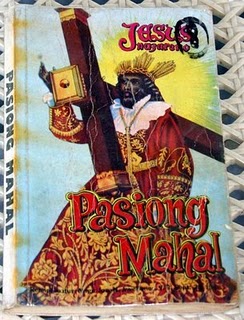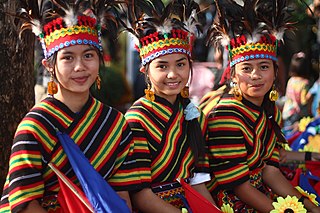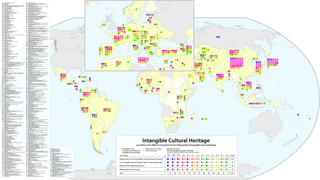Related Research Articles

Ifugao, officially the Province of Ifugao, is a landlocked province of the Philippines in the Cordillera Administrative Region in Luzon. Its capital is Lagawe and it borders Benguet to the west, Mountain Province to the north, Isabela to the east, and Nueva Vizcaya to the south.
The culture of the Philippines is characterized by cultural and ethnic diversity. Although the multiple ethnic groups of the Philippine archipelago have only recently established a shared Filipino national identity, their cultures were all shaped by the geography and history of the region, and by centuries of interaction with neighboring cultures, and colonial powers. In more recent times, Filipino culture has also been influenced through its participation in the global community.
Philippine literature is literature associated with the Philippines from prehistory, through its colonial legacies, and on to the present.

The Pasyón is a Philippine epic narrative of the life of Jesus Christ, focused on his Passion, Death, and Resurrection. In stanzas of five lines of eight syllables each, the standard elements of epic poetry are interwoven with a colourful, dramatic theme.

Philippine mythology is rooted in the many indigenous Philippine folk religions. Philippine mythology exhibits influence from Indonesian, Hindu, Muslim, Shinto, Buddhist, and Christian traditions.

Philippine epic poetry is the body of epic poetry in Philippine literature. Filipino epic poetry is considered to be the highest point of development for Philippine folk literature, encompassing narratives that recount the adventures of tribal heroes. These epics are transmitted through oral tradition using a select group of singers and chanters.

Tourism is an important sector for the Philippine economy. The travel and tourism industry contributed 6.2% to the country's GDP in 2022; this was lower than the 12.7% recorded in 2019 prior to the COVID-19 lockdowns. Coastal tourism, encompassing beach and diving activities, constitutes 25% of the Philippines' tourism revenue, serving as its primary income source in the sector. Popular destinations among tourists include Boracay, Palawan, Cebu and Siargao. While the Philippines has encountered political and social challenges that have affected its tourism industry, the country has also taken steps to address these issues. Over the past years, there have been efforts to improve political stability, enhance security measures, and promote social inclusivity, all of which contribute to creating a more favorable environment for tourism, such as the Boracay rehabilitation.

The Rice Terraces of the Philippine Cordilleras are a World Heritage Site consisting of a complex of rice terraces on the island of Luzon in the Philippines. They were inscribed on the UNESCO World Heritage List in 1995, the first-ever property to be included in the cultural landscape category of the World Heritage List. This inscription has five sites: the Batad Rice Terraces and Bangaan Rice Terraces, Mayoyao Rice Terraces, Hungduan Rice Terraces and Nagacadan Rice Terraces, all in Ifugao Province. The Ifugao Rice Terraces reach a higher altitude and were built on steeper slopes than many other terraces. The Ifugao complex of stone or mud walls and the careful carving of the natural contours of hills and mountains combine to make terraced pond fields, coupled with the development of intricate irrigation systems, harvesting water from the forests of the mountain tops, and an elaborate farming system.

Grace Nono is a Filipino singer, known for her musical style based on traditional Filipino rhythms. She is also an ethnomusicologist, scholar of Philippine shamanism, and cultural worker.

The Epic of Koroghlu is a heroic legend prominent in the oral traditions of the Turkic peoples, mainly the Oghuz Turks. The legend typically describes a hero who seeks to avenge a wrong. It was often put to music and played at sporting events as an inspiration to the competing athletes. Koroghlu is the main hero of epic with the same name in Azerbaijani, Turkmen and Turkish as well as some other Turkic languages. The epic tells about the life and heroic deeds of Koroghlu as a hero of the people who struggled against unjust rulers. The epic combines the occasional romance with Robin Hood-like chivalry.

Hinilawod is an epic poem orally transmitted from early inhabitants of a place called Sulod in central Panay, Philippines. The term "Hinilawod" generally translates to "Tales From The Mouth of The Halawod River". The epic must have been commonly known to the Visayans of Panay before the conquest, since its main protagonists, like Labaw Donggon, were noted in the accounts of the Islanders' beliefs and recorded by early Spanish colonizers. One of these Westerners' accounts says that the adventures of this ancient hero of Panay were recalled during weddings and in songs. It was noted that there were still native Mondos of Dingle, Iloilo who worshipped Labaw Donggon even during the last years of the Spanish rule in the Philippines. These worshippers would stealthily enter a certain cave in Dingle in the evening of a certain day of the year, in order to render homage and to offer chickens, doves, rice, bananas, and pigs to the ancient Visayan god.
Jesus Tamayo Peralta is a painter, photographer, graphic artist, poet, anthropologist/archaeologist, essayist, and is also one of the prizewinning playwrights in the Philippines.

The Ifugao people are the ethnic group inhabiting Ifugao province in the Philippines. They reside in the municipalities of Lagawe, Aguinaldo, Alfonso Lista, Asipulo, Banaue, Hingyon, Hungduan, Kiangan, Lamut, Mayoyao, and Tinoc. The province is one of the smallest provinces in the Philippines with an area of only 251,778 hectares, or about 0.8% of the total Philippine land area. As of 1995, the population of the Ifugaos was counted to be 131,635. Although the majority of them are still in Ifugao province, some of them have moved to Baguio, where they work as woodcarvers, and to other parts of the Cordillera Region.

UNESCO established its Lists of Intangible Cultural Heritage with the aim of ensuring better protection of important intangible cultural heritages worldwide and the awareness of their significance. This list is published by the Intergovernmental Committee for the Safeguarding of Intangible Cultural Heritage, the members of which are elected by State Parties meeting in a General Assembly. Through a compendium of the different oral and intangible treasures of humankind worldwide, the programme aims to draw attention to the importance of safeguarding intangible heritage, which UNESCO has identified as an essential component and as a repository of cultural diversity and of creative expression.

Darangen is a Maranao epic poem from the Lake Lanao region of Mindanao, Philippines. It consists of 17 cycles with 72,000 lines in iambic tetrameter or catalectic trochaic tetrameter. Each cycle pertains to a different self-contained story. The most notable of which deals with the exploits of the hero Bantugan.
Biosphere reserves are areas comprising terrestrial, marine and coastal ecosystems. The biosphere reserve title is handed over by UNESCO. Each reserve promotes solutions reconciling the conservation of biodiversity with its sustainable use. Biosphere reserves are 'Science for Sustainability support sites' – special places for testing interdisciplinary approaches to understanding and managing changes and interactions between social and ecological systems, including conflict prevention and management of biodiversity. Biosphere reserves are nominated by national governments and remain under the sovereign jurisdiction of the states where they are located. Their status is internationally recognized.
Intangible cultural heritage (ICH) includes traditions and living expressions that are passed down from generation to generation within a particular community.

The Schools of Living Traditions (SLTs) are education institutions in the Philippines dedicated to indigenous arts, crafts and other traditions.
References
- 1 2 Peralta, Dr. Jesus (December 1, 2003). "In Focus: Ifugao Hudhud: Local to Global Dimension of the Sacred". National Commission for Culture and the Arts. Archived from the original on July 22, 2018. Retrieved April 10, 2019.
- ↑ Hudhud Tradition of the Ifugao, Ethnic Groups of the Philippines
- ↑ Dulay, Michele (May 2015). "The Ifugao Hudhud: Its Values Content". International Journal of Science and Research (IJSR). 4: 2776–2777.
- 1 2 Dulawan, Lourdes. Singing Hudhud in Ifugao. Report. Ateneo De Manila University. 2.
- ↑ "Hudhud Chants of the Ifugao". United Nations Educational, Scientific and Cultural Organization. Archived from the original on November 21, 2015. Retrieved April 14, 2019.
- ↑ "Hudhud (Epiko ng Ifugao)". WikaKids. Archived from the original on April 25, 2019. Retrieved March 7, 2019.
- ↑ "Hudhud". Tagalog Lang. Archived from the original on February 16, 2023. Retrieved March 30, 2019.
- ↑ Stanyukovich, Maria V. A Living Shamanistic Oral Tradition: Ifugao Hudhud, the Philippines. Report. Peter the Great Museum of Anthropology and Ethnography, Russian Academy of Sciences. 249.
- 1 2 Dulawan, Lourdes. Singing Hudhud in Ifugao. Working paper. Ateneo De Manila University. 4.
- ↑ Manuel, E. Arsenio. A Survey of Philippine Folk Epics. Report. The University of the Philippines Diliman. 21.
- 1 2 3 Michele J Dulay, 2015, The Values of the Ifugao Hudhud, International Journal of Science and Research.
- ↑ Dulay, Michele (May 2015). "The Values of the Ifugao Hudhud". International Journal of Science and Research (IJSR). 4: 2777–27779. Archived from the original on 2023-02-16. Retrieved 2019-04-25.